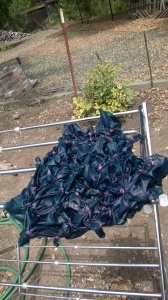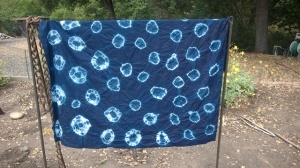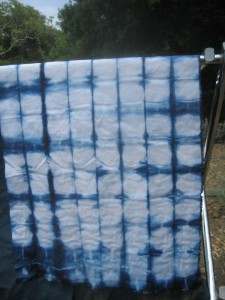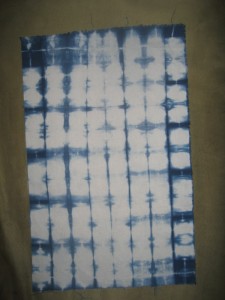Our meeting on a beautiful Sunday afternoon had us dipping into the indigo pot again. Once again we experimented with the results of various ways of patterning our fabrics.
And Shar processed some madder root for a red dyebath some day.

Sharing the thread of life
We had a lovely meeting with just a few choice members showing up: Sharolene, Frank, Lotus, Marcia and Phyllis. We continued with our indigo-dyed shibori project. There are some interesting comparisons of wet versus dry indigo in these pics. They are duplicated to show how much darker the wet indigo is.
This is Lotus Baker’s handspun handmade beautiful vest that she made for the CNCH fashion show a couple of weeks ago. You can’t tell by the look of it but it has a wonderful feel and drape. She made it using plain weave on her rigid heddle loom. These photos don’t do it justice.
We had a lovely day outside at Phyllis’s and the results of our resist dyeing paid off in spades with Frank’s shirts. They are stunning. The indigo pot was perfect and they were dipped several times with different members doing the timing after the timer–OOPS–was accidentally dropped in the water. Once they are dry we need to have good pictures of Frank wearing them.
The rain held of long enough for us to use the patio for the indigo dye pot. Sandy, Phyllis, Carol, Lotus, Elaine, Marcia and Anne used the pot and shared other projects. The indigo pot has been in use for around twenty years! and just needs a little refreshing and warmth to get it back up to speed each month. Here are some of the items we dyed.
There were other activities too. Lotus brought some yardage she has woven in plain weave on a rigid heddle loom from yarn leftover on weaving bobbins. While she was here, she worked on socks she is knitting from the toe up with both socks being knit at the same time on circular needles. Sandy used her sewing skills to mend a beautiful quilted Mung jacket that belongs to Phyllis.
There were probably other things going on too, but this is a sampling.
Saturday I folded and sewed. I found ironing the folds on the clamped pieces made for more accurate folds. I also found ironing the straight pleats for sewing made the sewing easier.
Itajime shibori is a shaped-resist technique. Traditionally, the cloth is sandwiched between two pieces of wood, which are held in place with string
Nui shibori includes stitched shibori. A simple running stitch is used on the cloth then pulled tight to gather the cloth
These are my results
Our indigo pot was strong and hearty. I brought cloth to dip into the pot and decided to put little rubber band resists all over the cloth to see what it would do. I did one, two and three rubber bands in different places. The three rubber band method turned out the best. Shown in the photos is the cloth after one dip with rubber bands still in and one after the indigo had oxidized. I was very happy with the results.


I decided to do 2 small pieces 18 X 11 inches. These will be used for covering the covers of handmade books.
Piece #1 I accordion pleated the long way with 1 1/2 inch pleats, giving me an 18 inch strip 1 1/2 inch wide. Then I pleated the the other direction in 1 1/2 inch pleats. This gave me a cube that I tied several times around both directions.
Piece #2 I accordion pleated the long way with 1 inch pleats, giving me an 18 inch strip 1 inch wide. Then I tied the strip about every 2 inches.

I then dipped them in the indigo 3 times; The 2nd and 3rd time I dipped Piece #1, I opened the folds on the corners slightly.


Our dye pot was Strong so I only left the pieces in for 1 to 2 minutes.

Here are the pieces wet.




Very little dye rinsed out and there is no crocking. As you can see the darkest blues are almost as strong dry as they were wet!
We had a wonderful indigo dye day today. Frank Mikulastic and Sandra Kupper had items to dye. We have been experimenting with shibori folding techniques and tried some new ideas today.
 Frank started with white cotton fabric. He folded the fabric in the long direction and then folded it into a triangle bundle. He then wrapped rubber bands around the outside to hold it together in the dye bath.
Frank started with white cotton fabric. He folded the fabric in the long direction and then folded it into a triangle bundle. He then wrapped rubber bands around the outside to hold it together in the dye bath.
He dipped it into the dye bath 5-6 times and the fabric got darker with each dip into the indigo. (With indigo, the best way to get a darkly dyed fabric is to do multiple dips, not with stronger dye.)
 Sandy wrapped her fabric around a pvc pipe and tied it with string then dip dyed it about 3 times for a fantastic looking diagonal stripe.
Sandy wrapped her fabric around a pvc pipe and tied it with string then dip dyed it about 3 times for a fantastic looking diagonal stripe.
She also dyed socks and a t-shirt – both had been unsuccessfully dyed once before with procion type dyes. Both items dyed beautifully this time.